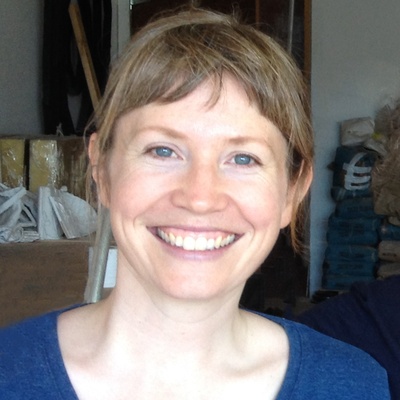
Sara Black
Sara Black with Tangelic Talks
I hold commitments as a visual artist, researcher, pedagogue, homeschooling parent, greenskeeper and environmental justice activist. My artwork uses durational processes of building, horticultural practices, and material transformation as a time-based method and diseased wood, ecosystem-specific trees/plants, unique landscapes, inherited building materials or other exhausted objects as material. I work to expose the complex ways in which things, people and other beings are suspended in and making worlds together. The work interrogates and re-presents the artifice of the autonomous liberal subject. I do this to make visible living beings' porosity and interdependence, which runs contrary to many of our larger exploitative cultural narratives in the US and North America. I am devoted to various collaborative projects that illuminate the value of extra-human relationships and the inherent value of the life-worlds of other beings. This work joins a much larger social movement of artists, scientists, indigenous knowledge keepers, and cultural/social theorists working to imagine a liveable future (not only for we human-types) where we can imagine rapidly evolving the dominant narratives that drive life-eliminating extractive practices.
For both conceptual but also highly practical reasons, I work in collaborative groups where ecologies of practice are revealed, rendering them both visible and durational. In other words, collaboration highlights inter-subjectivity, the awareness of others, both human and other, which results in a deep engagement with context or site. Object, material, event, tool, time, self and other are all in. Right now I am collaborating with artist Amber Ginsburg, political theorist Sam Frost, and digital artist and technologist Marc Downie in an experimental multi-year project called Untidy Objects. I am a member of Deep Time Chicago, an art, research, and activism initiative whose goal is to explore one core idea: humanity as a geological agent, capable of disrupting the earth system and inscribing present modes of existence into deep time. The collective knits together group readings, guided walks, lectures, panels, screenings, performances, publications and exhibitions. I am part of a newly-generated collective called the Mississippi River Open School for Kinship and Social Exchange. We explore the anthropocene conditions of the Mississippi River watershed. The Open School is an expansive educational and research collaboration of five river hubs spanning the river's headwaters to the Gulf. I act as a delegate for the Anthropocene Commons, a global network of researchers, educators, activists, artists and scientists. By commoning our skills, knowledge and resources, this expansive community imagines and explores practices of transformative pedagogies and collective action. Finally, I am a founder of and teacher with the collective Project Fielding, an organization that empowers women and gender variant people of all ages through skill-camps and design/build workshops that teach hand and power tool use and context-responsive design.
I received my MFA from the University of Chicago in 2006. I am currently Associate Professor and Chair of Sculpture at the School of the Art Institute of Chicago. I've exhibited nationally and internationally in a variety of spaces including Chicago’s Museum of Contemporary Art, The Smart Museum of Art, Gallery 400, Hyde Park Art Center, ThreewallsSOLO; Antennae in New Orleans; Portland’s Museum of Contemporary Craft; New York’s Park Avenue Armory, and Eyebeam; Boston’s Tuft University Gallery; Minneapolis’ Soap Factory; the Wormfarm Institute in Wisconsin, the HKW in Berlin and the Thailand Biennial. I am is a recent fellow with the Gray Center for Arts and Inquiry at the University of Chicago and current fellow with the Neubauer Collegium. This year I produced a work for the Anthropocene Campus Latin America in Rio, Brazil.
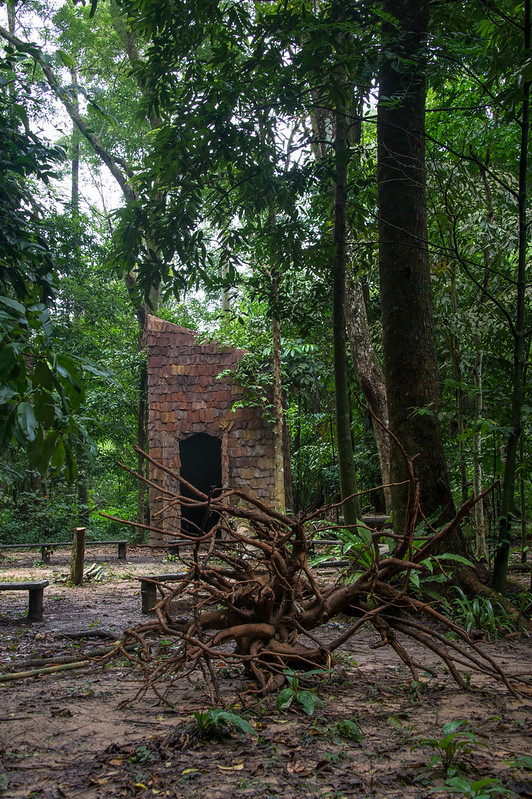
Featured Artworks
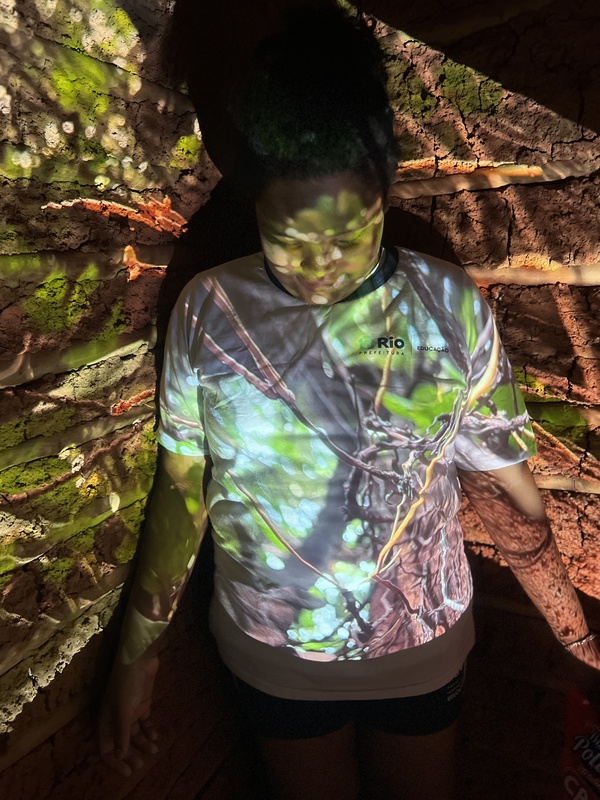 The Kinship Project: Atlantic Forest
Sara Black, Ananda Casanova, Bryce Parsons-Tweston
The Kinship Project is an ongoing creative movement to support adolescents coming-of-age in their home community/biome to ritually connect with an animal, plant or landform with whom they can foster a life-long connection. The Kinship Workshop at the Anthropocene Campus Latin America invites children aged 8 to 10 to connect with a “kin being” within the Atlantic Forest biome, imagining what it would be like to cultivate a kinship relationship over time, into the age of their parents or grandparents. In this workshop, participants will connect with tree-beings inhabiting the Passeio Público of Rio de Janeiro, exploring what it means to grow older in their presence. Through activities such as creative writing, collage, and correspondence with their present-future selves, they will imagine what kinds of relationships with the times we call “the future” become possible when we become-with tree-beings.
The Kinship Project: Atlantic Forest
Sara Black, Ananda Casanova, Bryce Parsons-Tweston
The Kinship Project is an ongoing creative movement to support adolescents coming-of-age in their home community/biome to ritually connect with an animal, plant or landform with whom they can foster a life-long connection. The Kinship Workshop at the Anthropocene Campus Latin America invites children aged 8 to 10 to connect with a “kin being” within the Atlantic Forest biome, imagining what it would be like to cultivate a kinship relationship over time, into the age of their parents or grandparents. In this workshop, participants will connect with tree-beings inhabiting the Passeio Público of Rio de Janeiro, exploring what it means to grow older in their presence. Through activities such as creative writing, collage, and correspondence with their present-future selves, they will imagine what kinds of relationships with the times we call “the future” become possible when we become-with tree-beings.
 Untidy Objects, Ongoing
Sara Black, Amber Ginsburg, Samantha Frost, Marc Downie
Untidy Objects is an emerging living sculpture on the south side of Chicago comprising seven biome types in a half acre field. The aim of the project is to foreground the porosity and co-constitution of living systems so as to articulate a form of politics that includes all this life within its purview. However, it is hard to visualize how such untidy objects might be recognized as political subjects. Consequently, we are experimenting with integrating technology into the biomes. This experimental technology immerses participants in a textual and physically dynamic situation where they can have a sensorial, exploratory experience of the forms of interdependence that constitute this lively sculpture. This grant would give us the funds and resources to release the experience of the untidy object from its site-specific context. We propose a virtual reality installation that will exploit this emerging medium’s capacity to intertwine participants within dynamic, ambiguous and diagrammatic networks. By co-registering sculptural objects in the installation and virtual spaces, we will give audiences an embodied, multi-sensorial experience of otherwise invisible processes that underpin life. This effort, then, goes beyond attempts at merely depicting natural objects or representing nature immersively; we seek to use virtual reality to enable audiences to experience our co-constitution–with the idea that such experiences will draw out the ways in which our mutual interdependence predicates responsibilities and obligations that are currently not captured within human-centered legal frameworks.
Untidy Objects, Ongoing
Sara Black, Amber Ginsburg, Samantha Frost, Marc Downie
Untidy Objects is an emerging living sculpture on the south side of Chicago comprising seven biome types in a half acre field. The aim of the project is to foreground the porosity and co-constitution of living systems so as to articulate a form of politics that includes all this life within its purview. However, it is hard to visualize how such untidy objects might be recognized as political subjects. Consequently, we are experimenting with integrating technology into the biomes. This experimental technology immerses participants in a textual and physically dynamic situation where they can have a sensorial, exploratory experience of the forms of interdependence that constitute this lively sculpture. This grant would give us the funds and resources to release the experience of the untidy object from its site-specific context. We propose a virtual reality installation that will exploit this emerging medium’s capacity to intertwine participants within dynamic, ambiguous and diagrammatic networks. By co-registering sculptural objects in the installation and virtual spaces, we will give audiences an embodied, multi-sensorial experience of otherwise invisible processes that underpin life. This effort, then, goes beyond attempts at merely depicting natural objects or representing nature immersively; we seek to use virtual reality to enable audiences to experience our co-constitution–with the idea that such experiences will draw out the ways in which our mutual interdependence predicates responsibilities and obligations that are currently not captured within human-centered legal frameworks.
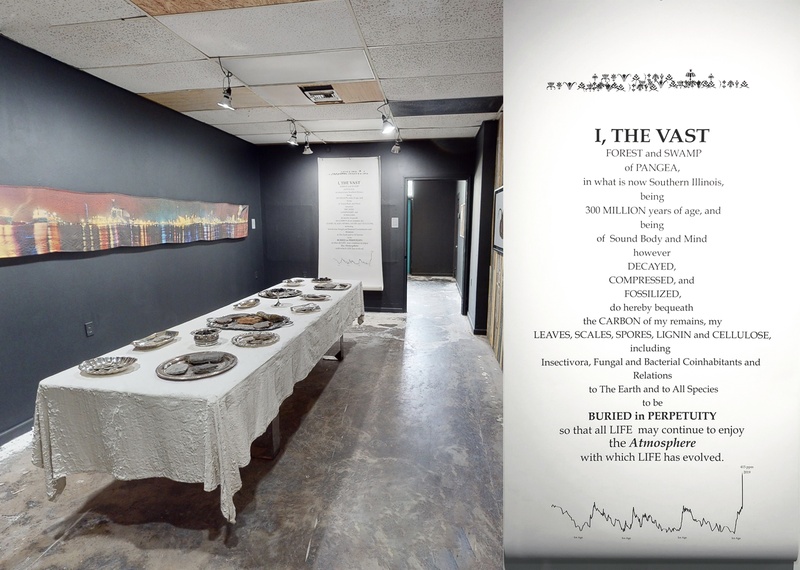 Inheritance, 2023
Sara Black, Sarah Lewison, Kayla Anderson, Claire Pentecost, Amber Ginsburg
Inheritance, 2023
Sara Black, Sarah Lewison, Kayla Anderson, Claire Pentecost, Amber Ginsburg
Beneath the rolling hills of Southern Illinois lies a fossilized section of a vast forest swamp that thrived 300 million years ago. Stretching for 100 miles along both sides of the ancient river as wide as the Mississippi, this fossil forest cuts across the heart of the Illinois Basin coal seam, forged from peat soils where ferns and giant trees (Arborescent Lycopods) once anchored their roots. It took over 300 million years to sequester the carbon that lies under Southern Illinois in the form of coal. It has taken a mere 200 years, and the labor of thousands of coal miners, to extract that carbon destined to fuel the lifestyle that defines our inheritance. Miners are on the front lines. Many of them have seen the remnants of the fossil forest that remains hidden to those above ground. Coal miners are also the first to personally experience the costs of the industry. The sculpture is exhibited with a 20-minute audio work presenting the voices of local miners and geologists, and the second a sculptural installation and text work. Insurgent Ecologies exhibition, Antennae Gallery, New Orleans Confluence Ecologies exhibition, Watershed Art and Ecology, Chicago, Confluence Ecologies exhibition, Southern Illinois University Field Station 4: Mississippi. An Anthropocene River, Carbondale
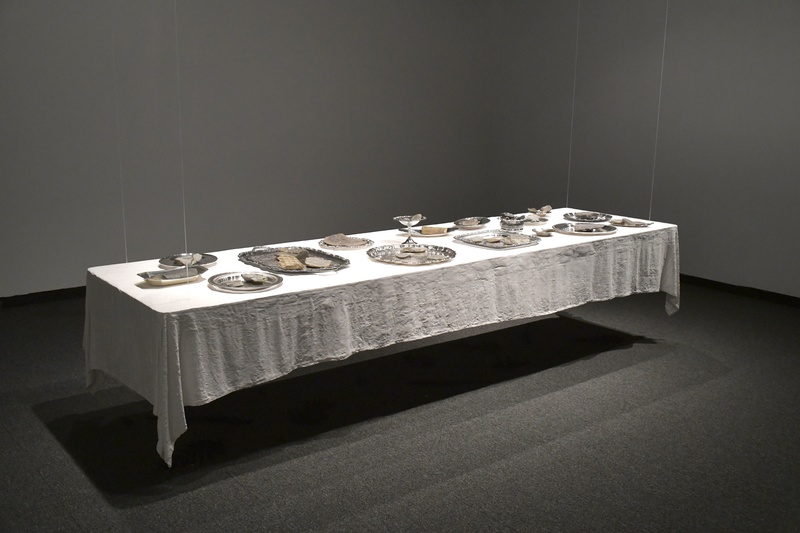 Inheritance, 2019
Sara Black, Claire Pentecost, Amber Ginsburg, Sarah Lewison
Inheritance, 2019
Sara Black, Claire Pentecost, Amber Ginsburg, Sarah Lewison
Beneath the rolling hills of Southern Illinois lies a fossilized section of a vast forest swamp that thrived 300 million years ago. Stretching for 100 miles along both sides of the ancient river as wide as the Mississippi, this fossil forest cuts across the heart of the Illinois Basin coal seam, forged from peat soils where ferns and giant trees (Arborescent Lycopods) once anchored their roots. It took over 300 million years to sequester the carbon that lies under Southern Illinois in the form of coal. It has taken a mere 200 years, and the labor of thousands of coal miners, to extract that carbon destined to fuel the lifestyle that defines our inheritance. Miners are on the front lines. Many of them have seen the remnants of the fossil forest that remains hidden to those above ground. Coal miners are also the first to personally experience the costs of the industry. The sculpture is exhibited with a 20-minute audio work presenting the voices of local miners and geologists, and the second a sculptural installation and text work. Insurgent Ecologies exhibition, Antennae Gallery, New Orleans Confluence Ecologies exhibition, Watershed Art and Ecology, Chicago, Confluence Ecologies exhibition, Southern Illinois University Field Station 4: Mississippi. An Anthropocene River, Carbondale
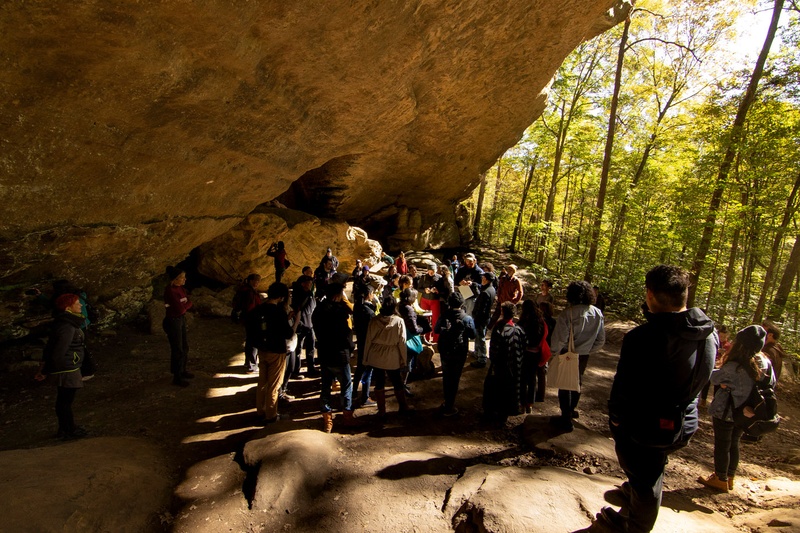 Carboniferous Walk-About-It, 2019 Ferne Clyffe State Park, Goreville, IL Field Station 4: Mississippi. An Anthropocene River
Carboniferous Walk-About-It, 2019 Ferne Clyffe State Park, Goreville, IL Field Station 4: Mississippi. An Anthropocene River
As part of Field Station 4, the Carboniferous Walk-About-It, was an example of one of Deep Time Chicago’s regular strategies, acknowledging that the Anthropocene calls for first person science, where we may derive abstract theorems from lived experience. On the second day of the three-day Field Station gathering, forty plus people filed out of an iconic yellow school bus, a mobile steel-body made ambulant through the combustion of fossilized plants and animals (oil and gas) that lived and died between 10 and 180 million years ago. We stepped onto ground that was located just south of the equator 300 million years ago during the geologic epoch referred to as the Carboniferous. The five members of Deep Time Chicago who organized this walk, Amber Ginsburg, Claire Pentecost, Kayla Anderson, Sara Black and Sarah Lewison, did so with the intention of creating a provocative and exploratory juxtaposition to their sound and sculptural installation titled Inheritance, presented to the public for the first time the night prior at the Southern Illinois University Museum, part of the Confluence Ecologies exhibition. On the walk we learned from Scott Elrick and Jeremy Breeden, two geologists with the Illinois State Geologic Survey. The fossil forest system that is the subject of Inheritance straddled an ancient river basin that meandered across these lands 300 million years ago. The swampy peat soils from which the now-fossilized forest grew, became the coal seams that have fueled the coal industry of southern Illinois and neighboring states. The fossil forest, a rare picture of a complex ecosystem, was rather rapidly covered over by fluvial sediments during a warming period not fully dissimilar to the one we are experiencing now, this time fueled by anthropogenic intervention. The geology of Ferne Clyffe demonstrates this fluvial geology and locks in stone this 300 million year old story.
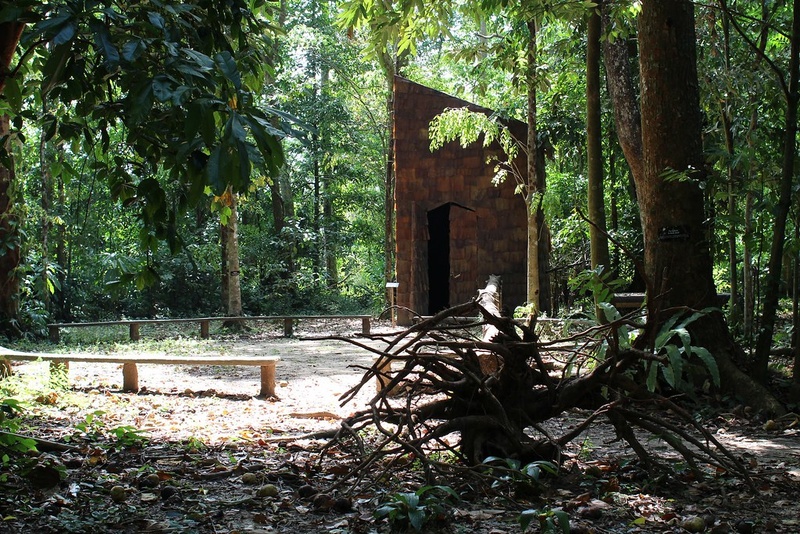 le Museé du le Grand Dehors|The Museum of the Great Outdoors, 2018-19
Sara Black, Amber Ginsburg and Charlie Vinz
le Museé du le Grand Dehors|The Museum of the Great Outdoors, 2018-19
Sara Black, Amber Ginsburg and Charlie Vinz
The US contribution to the Thailand Biennial, Le Museé du Grand Dehors is a sculptural work that uses a tree as the conceptual lens through which we critically examine and expand our experience of western, human-centered notions of ‘nature’ and environment. The title is drawn from the French philosopher Quentin Meillassoux of the speculative realism movement who refers to le grand dehors as that which reaches outside of possible human perception or knowledge. A 100 ft long commercial rubber tree is installed in Than Bok Khoranee Park, Thailand, one section, inside a raw rubber clad structure, is transformed from wood into charcoal, or pure carbon, held like a breath for up to 2000 years. Inside, the wall and tree are all carbon and offer a glimpse into deeper time, carbon time. “We are stardust, we are golden. We are billion-year-old carbon.”
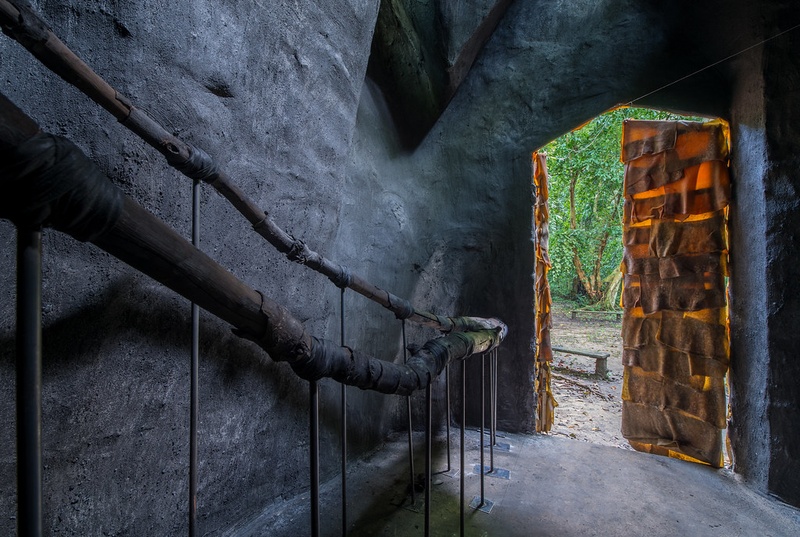 le Museé du le Grand Dehors|The Museum of the Great Outdoors, 2018-19
Sara Black, Amber Ginsburg and Charlie Vinz
le Museé du le Grand Dehors|The Museum of the Great Outdoors, 2018-19
Sara Black, Amber Ginsburg and Charlie Vinz
The US contribution to the Thailand Biennial, Le Museé du Grand Dehors is a sculptural work that uses a tree as the conceptual lens through which we critically examine and expand our experience of western, human-centered notions of ‘nature’ and environment. The title is drawn from the French philosopher Quentin Meillassoux of the speculative realism movement who refers to le grand dehors as that which reaches outside of possible human perception or knowledge. A 100 ft long commercial rubber tree is installed in Than Bok Khoranee Park, Thailand, one section, inside a raw rubber clad structure, is transformed from wood into charcoal, or pure carbon, held like a breath for up to 2000 years. Inside, the wall and tree are all carbon and offer a glimpse into deeper time, carbon time. “We are stardust, we are golden. We are billion-year-old carbon.”
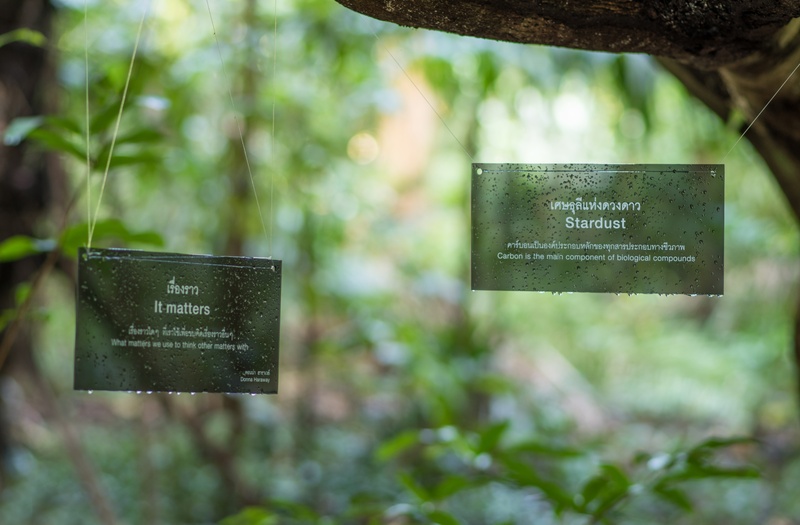 le Museé du le Grand Dehors|The Museum of the Great Outdoors, 2018-19
Sara Black, Amber Ginsburg and Charlie Vinz
le Museé du le Grand Dehors|The Museum of the Great Outdoors, 2018-19
Sara Black, Amber Ginsburg and Charlie Vinz
The US contribution to the Thailand Biennial, Le Museé du Grand Dehors is a sculptural work that uses a tree as the conceptual lens through which we critically examine and expand our experience of western, human-centered notions of ‘nature’ and environment. The title is drawn from the French philosopher Quentin Meillassoux of the speculative realism movement who refers to le grand dehors as that which reaches outside of possible human perception or knowledge. A 100 ft long commercial rubber tree is installed in Than Bok Khoranee Park, Thailand, one section, inside a raw rubber clad structure, is transformed from wood into charcoal, or pure carbon, held like a breath for up to 2000 years. Inside, the wall and tree are all carbon and offer a glimpse into deeper time, carbon time. “We are stardust, we are golden. We are billion-year-old carbon.”
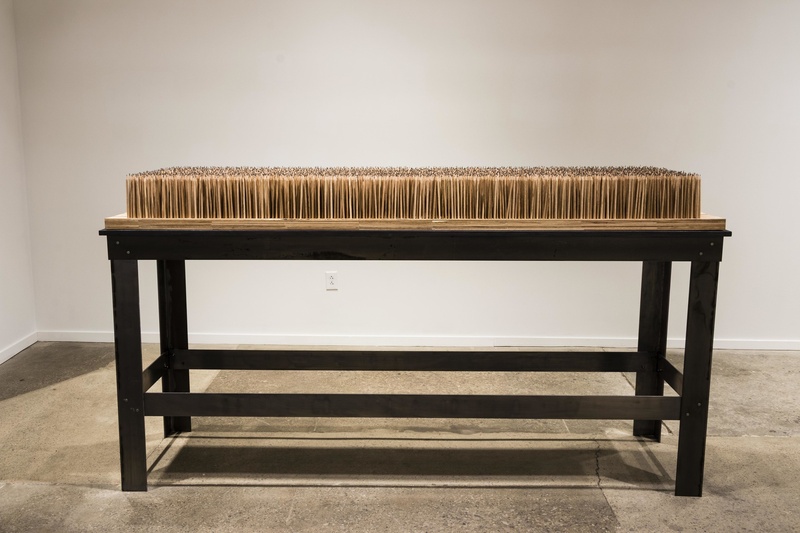 7000 Marks, 2017-present
Sara Black and Amber Ginsburg
7000 Marks, 2017-present
Sara Black and Amber Ginsburg
For 7000 Marks, we felled a Sudden Oak Death (SOD) infected tanoak tree, in California, which was quarantined inside the boundary of their county line until processed into lumber and kiln dried. This tightening of boundaries is a move toward environmental conservation, but echoes a rising tide of boundary reinforcement on a global scale. Kiln drying the wood-to-lumber so it could be shipped to Chicago, we fabricated 7,000 artist-made pencils, used in exhibitions and workshops to explore ideas of boundaries in collaboration with speculative fiction writers, scientists, activists and artists.
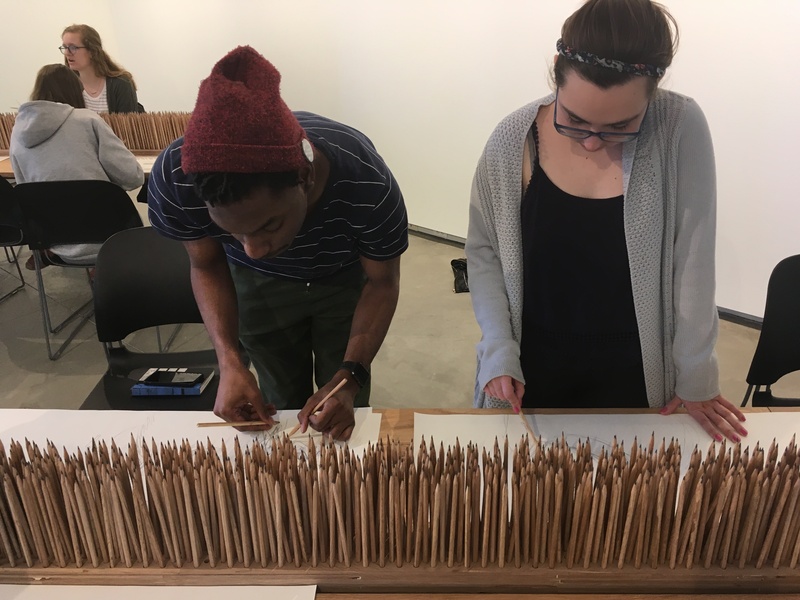 7000 Marks, 2017- ongoing
Sara Black and Amber Ginsburg
7000 Marks, 2017- ongoing
Sara Black and Amber Ginsburg
For 7000 Marks, we felled a Sudden Oak Death (SOD) infected tanoak tree, in California, which was quarantined inside the boundary of their county line until processed into lumber and kiln dried. This tightening of boundaries is a move toward environmental conservation, but echoes a rising tide of boundary reinforcement on a global scale. Kiln drying the wood-to-lumber so it could be shipped to Chicago, we fabricated 7,000 artist-made pencils, used in exhibitions and workshops to explore ideas of boundaries in collaboration with speculative fiction writers, scientists, activists and artists.
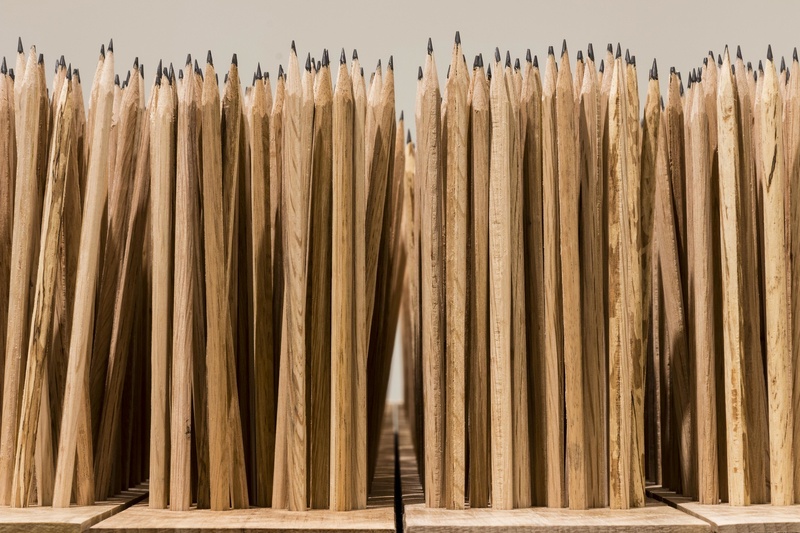 7000 Marks, 2017-present
Sara Black and Amber Ginsburg
7000 Marks, 2017-present
Sara Black and Amber Ginsburg
For 7000 Marks, we felled a Sudden Oak Death (SOD) infected tanoak tree, in California, which was quarantined inside the boundary of their county line until processed into lumber and kiln dried. This tightening of boundaries is a move toward environmental conservation, but echoes a rising tide of boundary reinforcement on a global scale. Kiln drying the wood-to-lumber so it could be shipped to Chicago, we fabricated 7,000 artist-made pencils, used in exhibitions and workshops to explore ideas of boundaries in collaboration with speculative fiction writers, scientists, activists and artists.
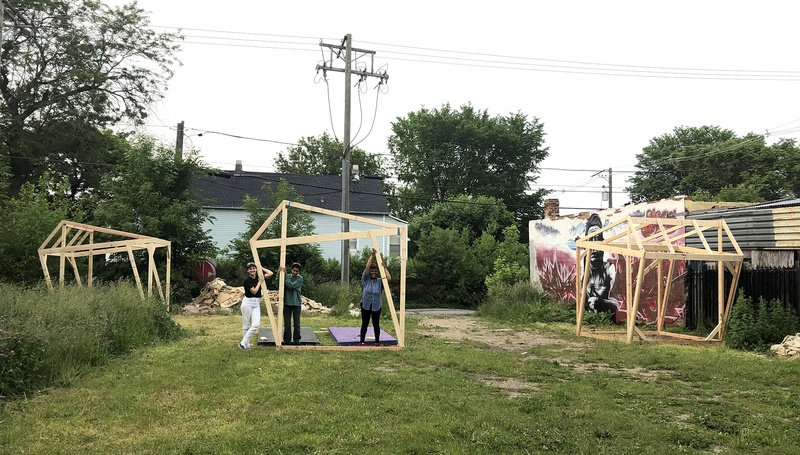 Resistance Architecture, 2019-2020
Project Fielding
Resistance Architecture, 2019-2020
Project Fielding
The Free Town Field Build is a design-build workshop organized by the teachers’ collective Project Fielding to create Resistance Architecture with and for members of the #LetUsBreathe Collective, an alliance of artists and activists who organize to imagine a world without prisons and police. Project Fielding defines Resistance Architecture as a series of structures designed and built to uplift the work of social justice organizations engaged in long term political protest or encampment. Twenty femme-identified and nonbinary builders came together over a period of nine days under the guidance of the Project Fielding teachers to learn practical woodworking skills while constructing the four shelters and two carts. Workshop participants included members of the #LetusBreathe Collective, Project Fielding alumni and newcomers from the Back of the Yards community and around Chicago who were interested in developing skills and/or supporting the work of #LetusBreathe and Project Fielding.
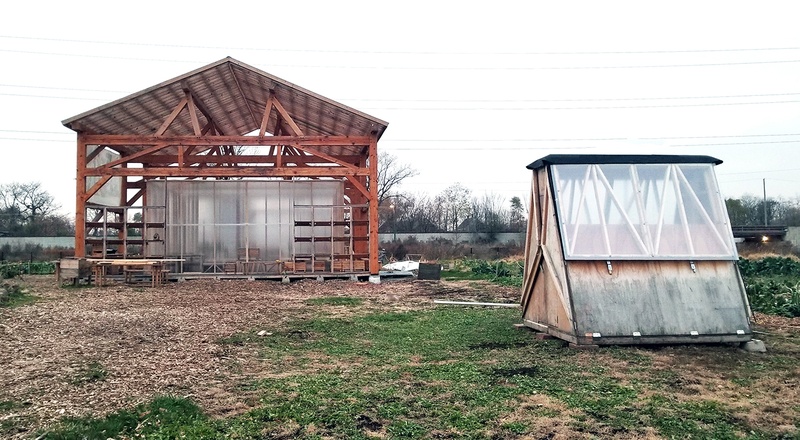 Resistance Architecture, 2018-2019
Project Fielding
Resistance Architecture, 2018-2019
Project Fielding
Designed and built by Project Fielding teachers and participants – Resistance Architecture is an adaptable structure intended for political encampment that was designed to fulfill the needs of long-term protesters. In recognition of a political climate which demands sustained resistance, Project Fielding led a design build workshop in February 2017 to create these two structures. This physically adaptive structure functions in two positions: open and in lockdown. When in lockdown, the structure serves as a locker or a safe. When open, the structure is a spacious and ready to use shelter. Project Fielding is honored to have Resistance Architecture present at The Sweetwater Foundation, where the structure was adapted for use as a shed and greenhouse on their urban farm. The Sweet Water Foundation uses “urban agriculture, art, and education to transform vacant spaces and abandoned buildings into economically and ecologically productive and sustainable community assets.”
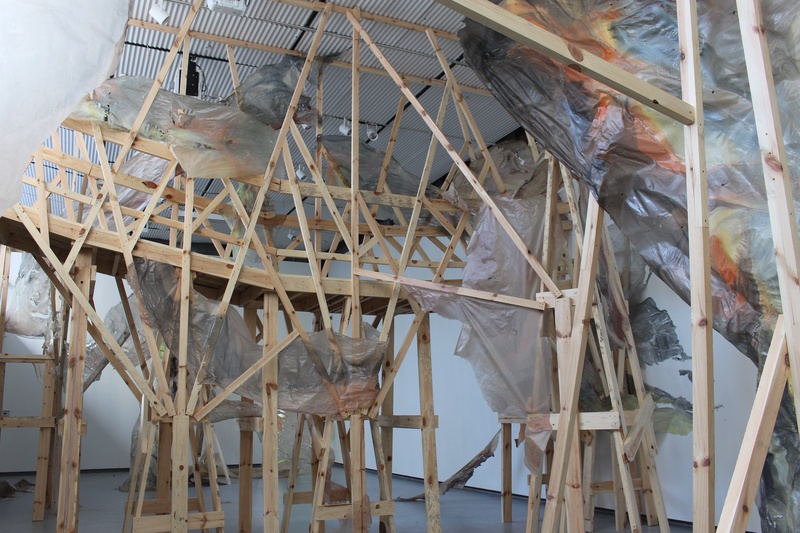 Edward Hines National Forest, 2018
Sara Black and Raewyn Martyn
Edward Hines National Forest, 2018
Sara Black and Raewyn Martyn
Sara Black and Raewyn Martyn collaborate to create the Edward Hines National Forest, an immersive built landscape that traces a material from plant to lumber and cellulose to produce hybrid forms that expose relationships between humans, the human-made and the larger ecosystem. Hines Lumber Company was one of the world’s largest lumber suppliers, founded in 1892, when the Chicago cityscape was under rapid expansion. The construction uses lumber and cellulose a substance extracted from the tree to create a biopolymer paint. These materials are derived from Diplodia pinea-exposed red pine trees grown in Hayward, Wisconsin. Skins of cellulose film are grafted into this architecture, transforming it into a hybrid forest system.The structures and materials are exposed from inside and outside, above and below, in an attempt to collapse conventional figure and ground relationships. Within this experience, visitors are drawn into coextensive relationships between surface, structure, skin and bones, human, non-human, inside and outside.
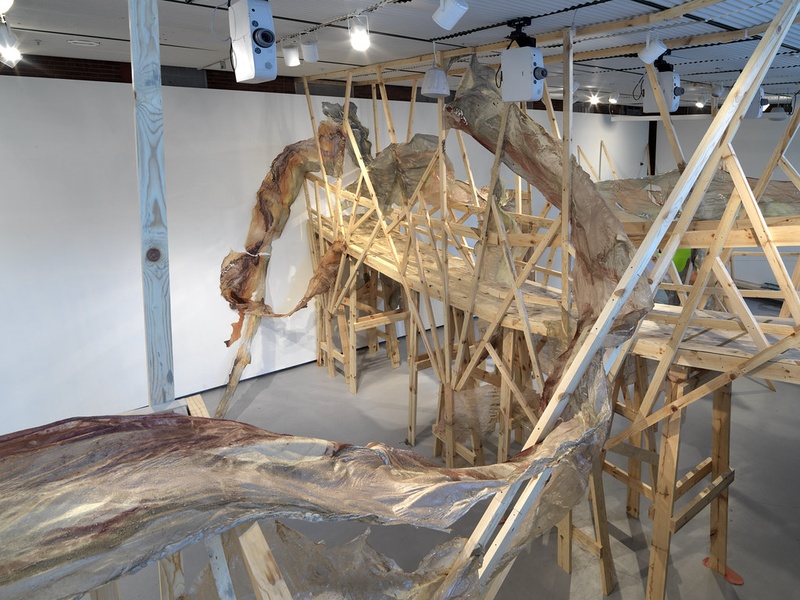 Edward Hines National Forest
Sara Black and Raewyn Martyn, Edward Hines National Forest, 2018
Edward Hines National Forest
Sara Black and Raewyn Martyn, Edward Hines National Forest, 2018
Sara Black and Raewyn Martyn collaborate to create the Edward Hines National Forest, an immersive built landscape that traces a material from plant to lumber and cellulose to produce hybrid forms that expose relationships between humans, the human-made and the larger ecosystem. Hines Lumber Company was one of the world’s largest lumber suppliers, founded in 1892, when the Chicago cityscape was under rapid expansion. The construction uses lumber and cellulose a substance extracted from the tree to create a biopolymer paint. These materials are derived from Diplodia pinea-exposed red pine trees grown in Hayward, Wisconsin. Skins of cellulose film are grafted into this architecture, transforming it into a hybrid forest system.The structures and materials are exposed from inside and outside, above and below, in an attempt to collapse conventional figure and ground relationships. Within this experience, visitors are drawn into coextensive relationships between surface, structure, skin and bones, human, non-human, inside and outside.
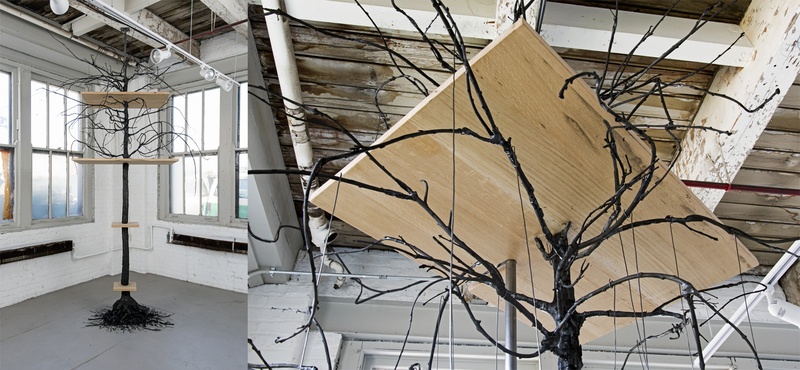 Witness Tree, 2017
Sara Black and Amber Ginsburg
Witness Tree, 2017
Sara Black and Amber Ginsburg
Witness Tree is a marker in both space and time. The title phrase is drawn from the colonial land survey practice used to grid the landscape into plots for private and government ownership. The bark of a witness tree was scarred for identification, and the property lines were drawn in relation to its placement. This Witness Tree is an entire young oak that has been transformed into pure carbon through charcoalization. Its position, in the corner of the gallery and of a city block, marks our relation to colonial attitudes of land use and resources. Its material – carbon now sequestered for up to 2000 years – allows us to glimpse beyond those attitudes into deep time.
Sara Black has crowd-funded a project with 3AP
-
- $3,187 raised of $3,000 goal
- 0 Days 0:00:00 LEFT
Commissioned by Harold Arts Residency, "Voyagers" will be a new large-scale sculpture involving the conversion and relocation of a 28-foot boat into an artist space and living quarters set amongst the towering trees of the residency property.
Read more about Voyagers -
- $8,050 raised of $5,000 goal
- 0 Days 0:00:00 LEFT
Fielding is an educational program geared to empowering young women and gender variant youth (ages 14-18) with design and build skills. Working in collaboration with a team of other skilled artists, I am raising funds to organize two week long …
Read more about Fielding -
- $13,723 raised of $6,000 goal
- 0 Days 0:00:00 LEFT
We’re about to have our very own woodshop! After operating for six years as an itinerant organization, Project Fielding will have a permanent home base in the Woodlawn neighborhood starting in early 2024. With this new woodshop, which includes classroom …
Read more about A Home for Project Fielding